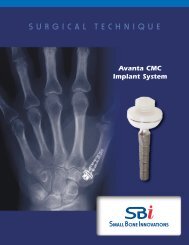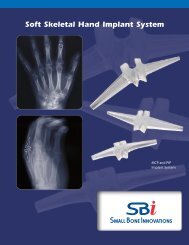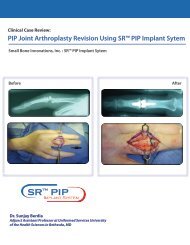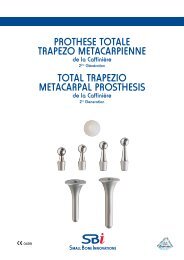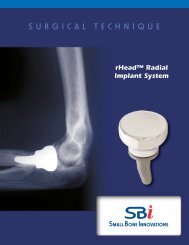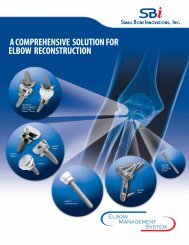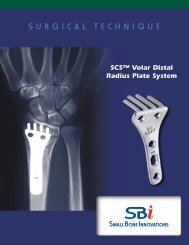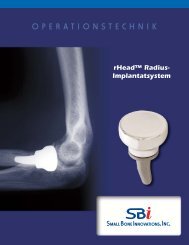PGT INSTRUmENTATIoN - Small Bone Innovations
PGT INSTRUmENTATIoN - Small Bone Innovations
PGT INSTRUmENTATIoN - Small Bone Innovations
You also want an ePaper? Increase the reach of your titles
YUMPU automatically turns print PDFs into web optimized ePapers that Google loves.
Preparation of the Talus<br />
Pin holes for securing position of block<br />
relative to talus<br />
The appropriate talar cutting guide is next inserted onto the tibial<br />
alignment guide. (FIGURES 11a+b & 12). The goal of the talar resection<br />
is to remove approximately 4 mm of bone from the talar dome.<br />
During the initial talar cut, the foot is held in a plantigrade position<br />
as the talus is pushed cephalad against the prepared surface of the<br />
tibia (or the tibial spacer block). There is a “0” cutting guide for normal<br />
or tight ankle joints, and cutting guides with 2, 4, and 6 mm<br />
spacers for relaxed joints.<br />
Care should be taken to hold the foot perpendicular to the long<br />
axis of the tibia. Holding the foot and ankle in excessive dorsiflexion<br />
will shift the final position of the talar implant anteriorly.<br />
Holding the foot and ankle in excess plantarflexion will result in<br />
positioning the talar component posteriorly.<br />
During talar dome resection, it is important to protect the malleoli.<br />
Pins can be placed in the ends of the cutting slot and malleable<br />
retractors or other angled retractors can be placed in the medial and<br />
lateral gutters.<br />
The angel wing can also be used here to verify the correct position<br />
of the talus prior to placement of fixation pins. Fixation pin holes<br />
are available on the medial and lateral aspects of the talar cutting<br />
guide to aid in maintaining the position of the talus during the talar<br />
osteotomy. After the osteotomy of the talus is completed, the bone<br />
fragment of the talar dome is removed and the joint is evaluated to<br />
assess the space following removal of both tibial and talar articular<br />
surfaces. A joint space evaluator instrument is placed into the prepared<br />
joint space. (FIGURE 13) One end of the instrument measures 12<br />
mm while the other end measures 9 mm. The 12 mm end of the joint<br />
space evaluator is positioned between the cut surfaces. A minimum<br />
of 12 mm is required as this is the space required for a 6 mm bearing<br />
with tibial and talar implants. If the 12 mm joint space evaluator does<br />
not fit, further tibial resection is required. The tibial cutting guide has<br />
pin holes marked for 2 mm and 4 mm recuts. (FIGURE 14) The cutting<br />
guide can be repositioned, and additional bone resected.<br />
Figure 11a<br />
Spacer for joints that are lax 2, 4 and 6 mm available<br />
Figure 11b<br />
9 mm<br />
Pin holes for recuts<br />
Figure 12<br />
12 mm<br />
Space evaluator<br />
Figure 13<br />
Figure 14<br />
8<br />
S.T.A.R. ® Scandinavian Total Ankle Replacement Surgical Technique



